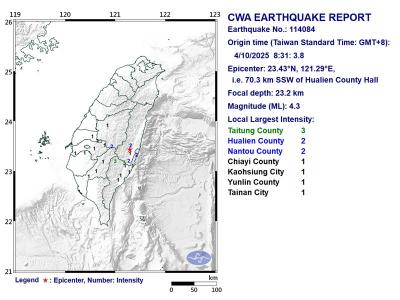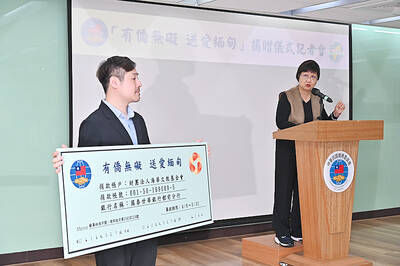The Ministry of Health and Welfare on Saturday announced that it would cancel its NT$600 million (US$20 million) “baby box” program proposal, which aimed to address the nation’s low fertility rate and the trend toward having fewer children.
The ministry in October proposed the program, which is modeled after a Finnish policy.
The so-called baby boxes would include childcare information and necessities for newborns, and each box would cost about NT$952 to produce.
The program was originally included as part of the Forward-looking Infrastructure Development Program.
The proposal faced a public backlash and on Oct. 17 a person claiming to be the mother of a two-year-old began a petition on the National Development Council’s online public policy participation platform requesting that the proposed budget be used instead to subsidize childcare and education for children aged two to five.
In a number of meetings and discussions with academics, experts and the public, all parties gave negative feedback and said that spending this money would not be effective, Minister of Health and Welfare Chen Shih-chung (陳時中) said, adding that the Executive Yuan asked that the money be spent where it is most needed.
The Executive Yuan and the Legislative Yuan also asked the ministry to reassess its proposal, Chen said, adding that fragmentary plans like the baby box program create excitement, but are not meaningful.
The Executive Yuan has a comprehensive plan for nurturing and recruiting talent, and the plan is also related to the trend of having fewer children, Chen said, adding that the resources would be integrated with those for the plan.
The baby box program was a mistaken decision that was forcibly added to the development program, Democratic Progressive Party Legislator Lin Ching-yi (林靜儀) said, adding that the ministry was correct to cancel it.
Taiwan Association of Obstetrics and Gynecology secretary-general Huang Min-chao (黃閔照) said that the decision was correct, as for regular families, the boxes would not be an incentive.
Women often worry that their jobs and positions would be affected after childbirth, Huang said, citing observations.
If the government could push for friendly workplace environments and allay women’s fear that their jobs will be affected if they have children, that would definitely raise the fertility rate, Huang added.
As the mission to tackle the falling fertility rate has already been transferred to the Executive Yuan and the National Development Council, the ministry would not develop new policies for the time being, Chen said.
According to statistics from the Ministry of the Interior, the number of newborns in the year as of the end of last month was 177,728 and if the current trend continues, the total number of newborns this year could be less than 200,000.

Taiwan is stepping up plans to create self-sufficient supply chains for combat drones and increase foreign orders from the US to counter China’s numerical superiority, a defense official said on Saturday. Commenting on condition of anonymity, the official said the nation’s armed forces are in agreement with US Admiral Samuel Paparo’s assessment that Taiwan’s military must be prepared to turn the nation’s waters into a “hellscape” for the Chinese People’s Liberation Army (PLA). Paparo, the commander of the US Indo-Pacific Command, reiterated the concept during a Congressional hearing in Washington on Wednesday. He first coined the term in a security conference last

A magnitude 4.3 earthquake struck eastern Taiwan's Hualien County at 8:31am today, according to the Central Weather Administration (CWA). The epicenter of the temblor was located in Hualien County, about 70.3 kilometers south southwest of Hualien County Hall, at a depth of 23.2km, according to the administration. There were no immediate reports of damage resulting from the quake. The earthquake's intensity, which gauges the actual effect of a temblor, was highest in Taitung County, where it measured 3 on Taiwan's 7-tier intensity scale. The quake also measured an intensity of 2 in Hualien and Nantou counties, the CWA said.

The Overseas Community Affairs Council (OCAC) yesterday announced a fundraising campaign to support survivors of the magnitude 7.7 earthquake that struck Myanmar on March 28, with two prayer events scheduled in Taipei and Taichung later this week. “While initial rescue operations have concluded [in Myanmar], many survivors are now facing increasingly difficult living conditions,” OCAC Minister Hsu Chia-ching (徐佳青) told a news conference in Taipei. The fundraising campaign, which runs through May 31, is focused on supporting the reconstruction of damaged overseas compatriot schools, assisting students from Myanmar in Taiwan, and providing essential items, such as drinking water, food and medical supplies,

Prosecutors today declined to say who was questioned regarding alleged forgery on petitions to recall Democratic Progressive Party (DPP) legislators, after Chinese-language media earlier reported that members of the Chinese Nationalist Party (KMT) Youth League were brought in for questioning. The Ministry of Justice Investigation Bureau confirmed that two people had been questioned, but did not disclose any further information about the ongoing investigation. KMT Youth League members Lee Hsiao-liang (李孝亮) and Liu Szu-yin (劉思吟) — who are leading the effort to recall DPP caucus chief executive Rosalia Wu (吳思瑤) and Legislator Wu Pei-yi (吳沛憶) — both posted on Facebook saying: “I